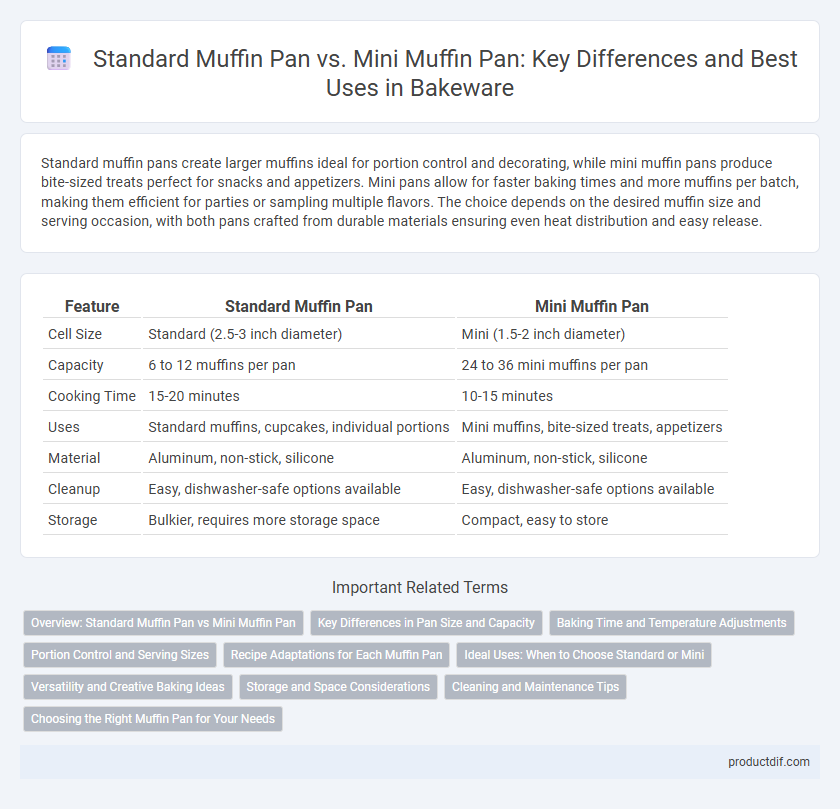Standard muffin pans create larger muffins ideal for portion control and decorating, while mini muffin pans produce bite-sized treats perfect for snacks and appetizers. Mini pans allow for faster baking times and more muffins per batch, making them efficient for parties or sampling multiple flavors. The choice depends on the desired muffin size and serving occasion, with both pans crafted from durable materials ensuring even heat distribution and easy release.
Table of Comparison
| Feature | Standard Muffin Pan | Mini Muffin Pan |
|---|---|---|
| Cell Size | Standard (2.5-3 inch diameter) | Mini (1.5-2 inch diameter) |
| Capacity | 6 to 12 muffins per pan | 24 to 36 mini muffins per pan |
| Cooking Time | 15-20 minutes | 10-15 minutes |
| Uses | Standard muffins, cupcakes, individual portions | Mini muffins, bite-sized treats, appetizers |
| Material | Aluminum, non-stick, silicone | Aluminum, non-stick, silicone |
| Cleanup | Easy, dishwasher-safe options available | Easy, dishwasher-safe options available |
| Storage | Bulkier, requires more storage space | Compact, easy to store |
Overview: Standard Muffin Pan vs Mini Muffin Pan
Standard muffin pans typically feature 12 cups with a capacity of about 3.5 ounces each, ideal for classic-sized muffins and cupcakes. Mini muffin pans provide 24 or more smaller cups, usually around 1 ounce, perfect for bite-sized treats or appetizers. Choosing between the two depends on recipe requirements and desired portion sizes for baking efficiency and presentation.
Key Differences in Pan Size and Capacity
A standard muffin pan typically measures 10 to 12 inches with 12 cups, each holding about 3.5 ounces of batter. In contrast, a mini muffin pan is smaller, usually around 8 to 10 inches with 24 cups, each cup holding about 1.5 to 2 ounces. The key difference lies in size and capacity, where the mini muffin pan allows for bite-sized portions and faster baking times, while the standard pan produces larger muffins suited for traditional recipes.
Baking Time and Temperature Adjustments
Standard muffin pans typically require baking at 350degF (175degC) for 18-22 minutes, while mini muffin pans bake faster due to their smaller size, usually needing 10-15 minutes at the same temperature. Adjusting baking time is crucial to prevent overbaking mini muffins, as their reduced volume causes quicker heat penetration. Temperature generally remains constant, but monitoring closely ensures moist, evenly baked results in both pan types.
Portion Control and Serving Sizes
Standard muffin pans typically hold 12 muffins with each cavity measuring about 2.5 inches in diameter, ideal for regular portion sizes suitable for single servings or snacks. Mini muffin pans, with cavities around 1.5 inches, produce smaller bites, allowing for better portion control in events or when serving multiple small treats. Choosing between the two depends on whether the goal is to deliver standard individual servings or multiple mini portions for dietary management or variety.
Recipe Adaptations for Each Muffin Pan
Standard muffin pans typically produce muffins around 3 inches in diameter, requiring recipes to bake for 18-22 minutes at 350degF, while mini muffin pans yield 1.5-inch muffins that need a shorter baking time of 10-15 minutes to avoid overcooking. Recipe adaptations often involve adjusting batter volume to prevent overflow; standard pans hold about 3 tablespoons per cup, whereas mini pans require roughly 1 tablespoon per cup of batter. Modifying ingredient proportions or baking temperature ensures even cooking and optimal texture for both muffin sizes.
Ideal Uses: When to Choose Standard or Mini
Standard muffin pans are ideal for recipes requiring larger muffins, such as breakfast muffins, savory dishes, or when a more substantial portion is desired. Mini muffin pans excel for bite-sized treats, appetizers, or portion-controlled snacks, perfect for kids' parties or appetizers at gatherings. Choosing between the two depends on portion needs and the specific recipe's desired presentation and serving size.
Versatility and Creative Baking Ideas
A standard muffin pan typically holds 12 cups, ideal for classic-sized muffins and cupcakes, offering versatility for recipes like cornbread or individual meatloaf servings. Mini muffin pans, with 24 or more smaller cups, enable creative baking by producing bite-sized treats such as mini quiches, petit desserts, or festive hors d'oeuvres. Both pans support diverse culinary experiments, but mini pans are especially suited for portion control and decorative presentations.
Storage and Space Considerations
Standard muffin pans typically measure around 12 inches by 17 inches and hold 12 cups, requiring more storage space compared to mini muffin pans, which are usually about 10 inches by 15 inches with 24 smaller cups. Mini muffin pans offer the advantage of compact storage due to their smaller size and often lighter weight, making them ideal for kitchens with limited cabinet space. The choice between the two depends on available storage capacity and intended baking volume, with mini pans conserving space while standard pans accommodate larger batches.
Cleaning and Maintenance Tips
Standard muffin pans often have larger cavities that can be more prone to batter residue, requiring thorough soaking and scrubbing with a non-abrasive sponge to maintain their non-stick surface. Mini muffin pans, due to their smaller size, can accumulate crumbs and grease in tight corners, making it essential to use a soft-bristle brush or toothpick for detailed cleaning. Both types benefit from drying completely before storage to prevent rust and occasional seasoning with oil to preserve their coating and extend lifespan.
Choosing the Right Muffin Pan for Your Needs
Selecting the right muffin pan depends on your baking goals and portion preferences. Standard muffin pans typically have 12 cups and produce muffins about 3 inches in diameter, ideal for classic-sized muffins and versatility in recipes. Mini muffin pans, with 24 or more smaller cups, create bite-sized treats perfect for appetizers, kid-friendly snacks, or party platters, offering faster baking times and easy portion control.
Standard Muffin Pan vs Mini Muffin Pan Infographic

 productdif.com
productdif.com